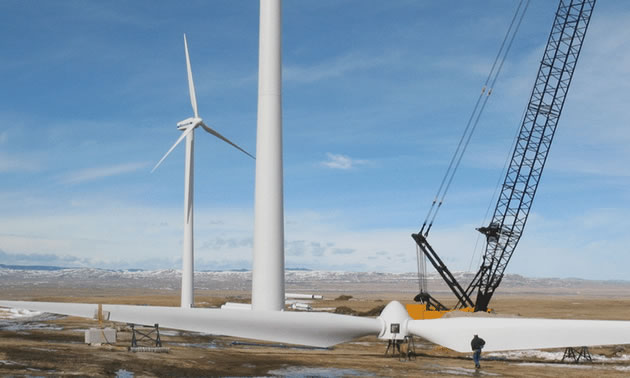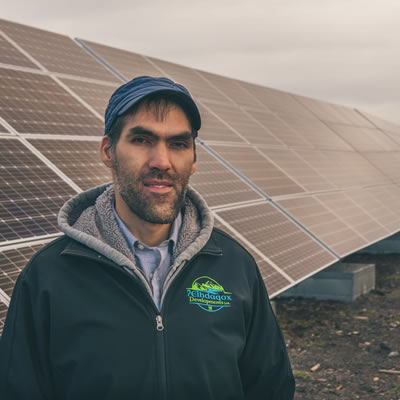Wind energy sector poised to deliver $3.7B in local spending to Alberta companies between now & 2030

Wind energy is the most cost-competitive source of renewable energy in Alberta today. — Photo courtesy CWEA/TransAlta
CALGARY, Sept. 27, 2017 /CNW/ - The Alberta Government's plan to add 5,000 MW of new renewable energy capacity by 2030 will deliver economic opportunities, in addition to environmental benefits, according to a new report by The Delphi Group for the Canadian Wind Energy Association (CanWEA), which was produced with funding support from the Alberta government.
As the most cost-competitive source of renewable energy in Alberta today, wind energy is well positioned to deliver the renewable energy required to meet the Alberta government's commitment. The report issued today, "Alberta Wind Energy Supply Chain Study", finds that if wind energy were to meet 90 per cent of the government's commitment, it would result in an estimated $8.3 billion of investment in new wind energy projects in the province.
According to the study, these projects are expected to result in $3.7 billion in spending in Alberta and almost 15,000 job years of employment by 2030, provided that the province creates the right enabling conditions to build on its existing strengths. The report also estimates that the wind industry will contribute $25.5 million in municipal property taxes and $13.5 million in land lease payments to Alberta land owners over the same period.
Alberta is already home to a highly skilled workforce that could support the growth of the wind energy sector. Many of the skills and occupations required to develop wind projects – such as engineering, construction, operations and maintenance – are transferable from the oil and gas sector. A long-term renewable energy procurement policy that sends clear signals to wind project developers and investors, will create the investment environment required to achieve these dramatic increases in local spending and job years. Expanding on Alberta's existing climate policy goals to include greater electrification of the economy would spur even further industry growth.
Informed by extensive research and consultation undertaken through 20 interviews with industry leaders, the report provides three recommendations for how Alberta can build on its strengths and realize the opportunities associated with developing its wind-energy sector:
1. Provide supportive policy and procurement conditions: A long-term renewable energy procurement roadmap through 2030 that aligns with the province's renewable energy target would increase the benefits of industry development. For example, announcing a series of large procurement plans (e.g., 1,500 MW every three years) that are rolled out in smaller, manageable phases will provide the investment certainty that increases the potential positive economic impacts.
2. Support workforce development and training: Developing specialized training related to wind energy manufacturing and operations and maintenance can help Alberta maximize employment potential in the growing sector. Government can play a key role in facilitating knowledge exchange and relationships between wind energy project developers and post-secondary education and training institutions. Options include convening meetings of industry stakeholders and training institutions and providing opportunities for two-way communication, and investing in initiatives that allow industry and academia to work closely together to identify relevant and timely training opportunities.
3. Promote the research and innovation agenda: Investments in innovation and research and development – particularly in the areas of transportation and logistics, wind farm construction and turbine erection, smart grid and system integration, and additive manufacturing/3D printing – will help Alberta build its knowledge-based workforce and export potential related to wind energy.
Download the full Alberta Wind Energy Supply Chain Study. The report was authored by The Delphi Group.
Quotes
"The report findings highlight that wind energy plays to Alberta's strengths, and that the province's highly skilled workforce is a tremendous foundation for growth in the sector. A clear, long-term procurement policy will ensure that Alberta can maximize the economic and environmental benefits associated with wind energy."
– Robert Hornung, President, Canadian Wind Energy Association (CanWEA)
"Developing the wind energy sector is a continuation of what Alberta already does well and will support the continued growth of the provincial economy. The advancement of renewable energy in Alberta will create jobs, diversify the economy, attract investment, and reduce carbon pollution."
– Carol-Ann Brown, Senior Director, The Delphi Group
"The wind energy sector provides enormous potential for employment growth in Alberta. We have a lot of great talent and a strong ecosystem in this province, we just need to help the province broaden our energy portfolio so that we remain competitive across all our sectors. The report provides direction on how best we can support and grow the next generation of jobs in this province."
– Mary Moran, President and CEO, Calgary Economic Development
Facts and key findings
- In 2016, the Government of Alberta established a Renewable Electricity Program (REP) that sets a target to ensure 30 per cent of Alberta's electricity will come from renewable sources by 2030 and established plans to add 5,000 MW of renewable energy capacity by 2030.1
- Key experts interviewed by The Delphi Group suggest that as much as 95 per cent of this new capacity in Alberta could come from wind energy projects.
- Alberta-based companies have developed approximately 32 per cent of Canada's total installed wind capacity of 11,205 MW as of 2016.
- If 90 per cent of the new renewable energy capacity added by 2030 comes from utility-scale wind farms, local spending in Alberta related to project development and construction could reach $3.6 billion, and with $137 million expected in local operations and maintenance spending, the total exceeds $3.7 billion. Approximately 14,862 direct person years of employment and 714 full-time equivalent jobs in Alberta could also be realized.
Significant opportunities exist for Alberta-based firms in the areas of:
- Environmental monitoring and site planning
- Excavating, concrete, steel, metal fabrication/welding, electrical work, and sub-station control systems
- Civil engineering work in areas such as road building and site preparation
- Construction and upgrading of sub-stations, transmission lines, and cabling
- Transportation of and route planning for large turbine components and equipmen
- Operations and maintenance, such as grid and system integration, balance-of-plant operations, security systems, and the monitoring and maintenance of electrical, SCADA, and control systems
- Significant transferrable skills and occupations exist between wind and other energy sectors across all phases, including project development, construction, and operations and maintenance.
- New technologies (such as advanced manufacturing, 3-D printing, and virtual reality) have the potential to revolutionize local production and reap further economic benefits for the province.
- With the growth of wind farms in Alberta, the need for more wind turbine technicians and operations-focused training presents an opportunity for local post-secondary education and training institutions to meet demand.
Alberta now ranks third in Canada with an installed wind energy capacity of 1,479 MW. The province's wind farms produce enough electricity each year to power 625,000 homes, equivalent to about six per cent of Alberta's electricity demand.
About the Canadian Wind Energy Association
CanWEA is the voice of Canada's wind energy industry, actively promoting the responsible and sustainable growth of wind energy. A national non-profit association, CanWEA serves as Canada's leading source of credible information about wind energy and its social, economic and environmental benefits. Join us on Facebook, follow us on Twitter and LinkedIn. Learn more at www.canwea.ca.
SOURCE: Canadian Wind Energy Association




